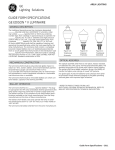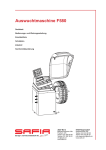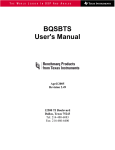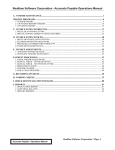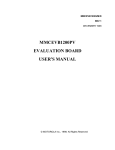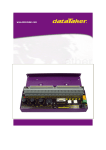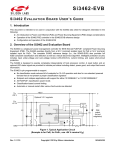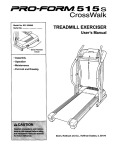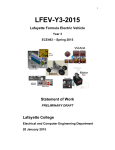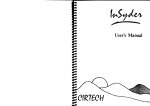Download EV2014 Gas Gauge Evaluation Board User Manual
Transcript
EV2014 Gas Gauge Evaluation Board Contents Section Page No. Introduction 1 EV2014 Functional Description 1 EV2014 Contents 2 EV2014 Connections 2 EV2014 Configuration 2 Installing the User Interface Program 3 Using the EV2014 Program 3 Main Menu 3 Monitor Screen 4 Digital Magnitude Filter Menu 6 Data Logging 6 Display Program Menu 7 Measure VOS Screen 8 Appendix A: AP14 User's Guide See the bq2014 data sheet (Dec. 1994 B or later) for bq2014 specifications. 9 Appendix B: Troubleshooting 10 Appendix C: EV2014 Schematic 11 Power Source The bq2014 derives its VCC from either an external source or from the battery connected to the BAT+ (J1) and BAT- (J2) terminal blocks. Refer to Table 4 in Using the bq2010-—A Tutorial for Gas Gauging for the proper size of R17 as part of the VCC regulation. The EV2014 Evaluation Board is shipped with a 200KΩ resistor for R17. Introduction The bq2014 Gas Gauge IC provides battery capacity monitoring in a single 16-pin SOIC or DIP package. The EV2014 Evaluation Board provides a useful means to test bq2014 functionality and easily interface with the device over the RS-232 port of a PC. The bq2014 features: n Battery capacity monitoring functions n LED display of available charge n DQ serial I/O port communications functions Current Path The bq2014 uses a sense resistor (R16) on the negative terminal of the battery to measure charge and discharge activity. This resistor may be changed if necessary. The system load is connected between the BAT+ (J1) and PACK-(J2) terminal blocks (see the schematic in Appendix C). Parameter Programming Functional Description The EV2014 is programmed by the segment programming pins, using jumpers PROG1-PROG6. The programming pins determine: The EV2014 provides functional evaluation of the bq2014 IC on a PCB. The actual implementation of a bq2014-based design will be significantly smaller in size. 10/97 n Programmed full count n Scale factor Rev. B Board 1 EV2014 n Self-discharge rate n Display mode jumper is removed, the pins are in the high-impedance state. The board is shipped with all pins in the high position. Please refer to the bq2014 data sheet (Dec. 1994 or later) for the proper configuration of PROG1-5. EV2014 Contents Each package contains the following items: 1 JP16 LED enable (LCOM connection). This jumper connectss the LCOM pin of the bq2014 to the LEDs. The board is shipped with this jumper enabled. EMPTY Empty output. This connection allows the user to monitor the EMPTY output pin provided on the bq2014. This pin is high-impedance when the single-cell divided battery voltage is less than the EDVF threshold (final end-of-discharge warning). DSP Display input (DISP pin). DSP is connected in parallel with the push-button switch S1 provided on the EV2014 board. An external switch configuration can be made using DSP. When the EV2014 is floating and detects charging or discharging, the LED outputs are active to reflect the charge state. When the DISP input is pulled low, the LEDs reflect the charge state. EV2014 PC Board This includes the bq2014 sample, current regulators, programming jumpers, battery divider resistors, and the PC serial port interface. 1 EV2014 DQ/RS-232 Cable 1 EV2014 (v2.0) User Interface Program Diskette This program runs on any AT-compatible computer equipped with a standard RS-232 (COM1, COM2, COM3, or COM4) serial port, and provides the user with a complete menu-driven system to control, monitor, and log data from the EV2014x Evaluation Board. The User Interface Program communicates with the bq2014 over the DQ serial I/O port using the RS-232 interface. Please check to make sure that all items are present and in good condition. If you have any problems, please contact your Benchmarq representative or call Benchmarq. EV2014 Connections EV2014 Configuration The connections for the EV2014 are described below. Please refer to the attached schematic in conjunction with these descriptions. JP1-JP8 JP9 JP10-JP14 The EV2014 Evaluation Board may be used with or without the DQ/RS-232 Interface Program. The Evaluation Board should first be configured before connecting the battery or the RS-232 cable. Battery cell divider. JP1-JP6 are used to divide the battery voltage by 5 to 10. JP7 and JP8 are user-definable but are configured for 11 and 12 cells on this board. Step 1 Enabling the LEDs (optional) JP16 should be installed Step 2 VCC Supply. This jumper is used to select the VCC supply for the bq2014. When JP9 is near Q2, the supply is taken from the BAT+ input and is regulated by the bq2014 and Q2. When JP9 is near R13, the VCC supply is provided by LBAT+. If VCC is supplied by LBAT+, it must not exceed the specified VCC voltage range in the bq2014 data sheet (Dec. 1994 B or later). Connecting the power supply The EV2014 can operate from power provided by the battery being monitored or from LBAT+. Set the battery divider (JP1-JP8) to the correct number of battery cells prior to connecting the battery. If the bq2014 will be powered from the battery, connect JP9 closer to Q2. If the bq2014 will be powered from an external supply, connect JP9 closer to R13. Important: Connect the battery ONLY after setting JP1-JP8 and JP9. Programming pins 1-5. These jumpers are used to configure the programming pins. When the jumper is positioned near the PROG# designator, the pins are pulled high. If the jumper is in the other position, the pins are pulled low. If the Step 3 Connecting the RS-232 cable Connect the cable provided to the serial port of any PC. Please ensure that no Rev. B Board 2 EV2014 Step 4 memory-resident programs are using this serial port. Using the EV2014 Program Connecting the load EV2014 is a menu-driven program. Almost all of the functions and entries are made by positioning the highlighted cursor on the function desired and pressing the ENTER key, or by typing a value and then pressing the ENTER key. The external load is connected between BAT+ and RET- (J2) on the EV2014. A sense resistor (R16) is in series with the negative terminal of the battery. The EV2014 board is supplied with a 0.1, 1% 3W resistor. Please ensure that the discharge load does not exceed the VSR specification for the bq2014. R16 may be changed to a different-value resistor. Key functions are as follows: Installing the User Interface Program The User Interface Program (named “EV2014”) runs on any PC-compatible computer. The program may be run from the disk provided, or it may be installed on any directory on the computer's hard disk. To run the program from the hard disk, simply copy all the files from the disk supplied to the hard disk. All the files should reside in the same directory. ARROW keys Use the arrow keys to move the highlighted cursor around the screen. ENTER key Press the ENTER key to select the value currently being displayed for a parameter, or to perform a function selected by the highlighted cursor. ESCAPE key Press the ESCAPE key to escape from any function back to the main menu, or to escape from any parameter value screen back to the menu displaying that parameter. F3 key Press the F3 key to display a help file for the selected function or parameter. Main Menu The User Interface Program installs a driver to control the DQ/RS-232 interface. This driver asks which COM port is connected to the EV2014 Evaluation board. If communication is not established with the EV2014 board, the Main Menu does not appear. Please refer to Appendix B (Troubleshooting) if the program does not establish communication with the EV2014. The Main Menu appears after the EV2014 program has started. If this menu does not appear, communication with the EV2014 has not been established; please refer to Appendix B (Troubleshooting) if the EV2014x does not display the Main Menu. The Main Menu shows six functions that may be activated; see Figure 1. Use the cursor keys (arrow keys) to position the highlighted cursor over the function to be activated and press the ENTER key. For help, press the F3 key, and a help note about the function appears. Press the ESCAPE key to exit from the EV2014 program. The EV2014x uses the PC-AT real-time clock to provide the proper bit timing for serial communication with the bq2014. The modem control lines are used as the single-wire serial interface to the bq2014. Any TSR that uses the PC real-time clock affects the operation of the EV2014. For proper operation, the EV2014 should not be operated from a DOS shell program. The Main Menu functions are as follows: If the PC is a notebook or portable type, it may be configured to save battery power by adjusting the clocks according to the activity under way. Configure the notebook to run in “High Performance” mode for reliable communication between the EV2014 and the PC. The EV2014 UIP terminates if communication with the EV2014 board is lost. <Initialize> Sends a reset command to the bq2014. <Monitor> Activates a screen from which the bq2014 activity is monitored on a real-time basis. <Digital Filter> Activates a screen from which the Digital Magnitude Filter can be changed. The default filter value is -0.3mV, +0.38mV. The bq2014 data sheet (Dec. 1994 B or later) defines valid options for this filter. <Data Log> Allows entering a file name to which bq2014 data will be logged, and the logging period in seconds. When the log is Start the User Interface Program as follows: C>EV2014 Rev. B Board 3 EV2014 times 256 and divided by the sense resistor to give mAh. activated, the display changes to the Monitor screen with a top display of: Logging Record: xx <Display Program Menu> Activates a screen showing the current program settings for the bq2014. <Measure VOS> This allows the user to determine the apparent offset voltage of the bq2014 under test. A minimum of 6 minutes are required to complete the VOS measurement, which has a resolution of ±0.15mV per 6 minutes. Sense Resistor Value This is the sense resistor value from the Programming menu. Average VSR Current This is the average battery current. Time Remaining During discharge only, this is the time remaining at the average current (NAC / Avg. VSR current) Digital This is the value of the digital magnitude Filter Setting filter. Temp Step This is a display of the active temperature step, which ranges from 0 (for temperatures <-30°C) to 12 for temperatures > 80°C). Activity This indicates the charging/discharging activity occurring with the battery. CHARGE is displayed if the battery is charging, while DISCHARGING is displayed if the battery is being discharged, or if it is idle (no charging taking place). OVERLOAD is displayed if the voltage drop across the sense resistor exceeds the VSR1 threshold. Please note that the appearance of CHARGE or DISCHARGE indicators is rate-dependent, and may take some time after the application of a charging current or a discharge load depending on the PFC and scale selected, and the rate of charge or discharge being applied. Monitor Screen This screen monitors real-time changes of the bq2014; see Figure 2. The program continually updates the monitor screen. As conditions change, the new values are displayed. Time Time of day in HH:MM:DD, 24-hour notation. Empty/Full This indicates the current value for GG in the TMPGG register of the bq2014. The capacity value is given in 1 16th steps. Date Current date in MM/DD/YY notation. NAC NAC register values multiplied by the scale value and divided by the sense resistor value to give mAh. LMD Last Measured Discharge expressed in terms of mAH. This is the 8-bit LMD register value multiplied by the scale value Benchmarq BQ2014 Evaluation Board Main Menu (v2.3) <Initialize> <Monitor> <Digital Filter> <Data Log> <Display Program> <Measure Vos> Please enter the SR, # of cells in Display Program for Proper Operation ESC to exit program F3 for Help Figure 1. Main Menu Rev. B Board 4 EV2014 VSR Step This is the value of the VSR current step as defined in the bq2014 data sheet. GG Step This is the lower four bits of the TMPGG register that correspond to the current NAC value relative to either the LMD or the original programmed full count (as determined by PROG1-4). The GG step is reported as a step number from 0 to 15, with step 0 representing available capacity from 0 to 1 16 of full, and 15 representing available capacity from 15 16 full to full. Charge Rate Indicates whether the present charge is TRICKLE or FAST depending on the state of the charge rate (CR) bit in FLGS2. First EDV This is the state of the EDV1 flag as programmed in the Display Program Menu. The default is 1.05V. The EDV1 flag latches ON if VSB drops below the EDV1 threshold value. It remains latched until charging is detected, at which time it is cleared. Cell voltage This is the cell voltage at the SB pin of the bq2014. Battery voltage This multiplies the cell voltage by the number of cells programmed in the Display Program Menu. The default is one cell. Battery Removed This is the state of the battery removed flag. It is set (BRM = yes) if one of the conditions indicating battery removed occurs. This flag is reset when the battery is replaced. Valid Discharge This is the state of the VDQ bit in FLGS1. VDQ = yes if the bq2014 is charged until NAC = LMD. VDQ = no indi- Benchmarq BQ2014 Evaluation Board Real-Time Monitor Screen Time: 99:99:99 EMPTY ****_____FULL NAC: 99999 mAH LMD: 99999 mAH Avg Vsr Current: ± 9999mA Date: 99-99-9999 Sense Resistor Value: XXXmΩ Time remaining: 9999 min. Digital Filter Setting: -0.XXmV=Vsrd +0.XXmV=Vsrq Temp Step: XX Activity: XXXXX Vsr Current Step: XX GG Step: XX Charge Rate: XXXX First EDV: XXX Batt. Rem'vd: XXX Valid Discharge: XXX Final EDV: XXX Batt. Repl'd: XXX Cell Voltage: XXX V Batt. Voltage: XXX V Capacity Inaccurate: XXX FLGS1: X C H G S X B R P X X X _ X B C V N E R I D / D M Q U V 1 ESC to main menu X E D V F Capacity Inaccurate Count: XXX FLGS2: X X X X C D D D R R R R 2 1 0 F1 to modify NAC _ N / U _ N / U _ N / U X O V L D F2 to modify LMD Figure 2. Real-Time Monitor Screen Rev. B Board 5 EV2014 Final EDV Battery Replaced cates the present discharge is not valid for LMD update. Digital Magnitude Filter Menu This is the state of the EDVF flag as programmed in the Display Program Menu. The value of EDVF is 0.1V lower than EDV1. The EDVF flag latches ON if VSB drops below the EDVF threshold value. It remains latched until charging is detected, at which time it is cleared. This menu sets the digital magnitude filter in the bq2014; see Figure 3. Any value from 1 to 255 is valid. Suggested values are displayed on the menu. Modifying NAC and LMD It is possible to change the values of the NAC and LMD parameters from the screen using the F1 and F2 function keys as follows. This is the state of the battery replaced flag. It is set (BRP = yes) if the battery valid condition returns after setting the battery removed flag. The battery replaced flag is cleared if the battery is discharged to the EDV1 level or if it is charged to NAC = LMD. This flag is set after a EV2014x initialization. Changing NAC (F1) 1) Press the F1 key. The NAC field is highlighted. 2) Enter the value in mAH and press the ENTER key to store the value. This is the state of the capacity inaccurate bit in FLGS1. It is set (CI = yes) to indicate that the battery capacity has not been updated during the last 64 charge cycles. Note: Changing NAC disqualifies a subsequent LMD update. Capacity Inaccurate Count This is the number of charge cycles between an LMD update. This counter is reset to zero when NAC = LMD after a valid LMD update. 1) Press the F2 key. The LMD field is highlighted. 2) Enter the value in mAH and press the ENTER key to store the value. FLGS1 This indicates the present state of the FLGS1 resistor. FLGS2 This indicates the present state of the FLGS2 resistor. Capacity Inaccurate Changing LMD (F2) Benchmarq BQ2014 Evaluation Board Digital Magnitude Filter Menu Enter DMF Value from List below: XXX Current Setting -0.XXmV=Vsrd +0.XXmV=Vsrq Current Threshold (DMF(mv)/Rsns): XXXXmA Suggested DMF Settings: DMF Vsrd(mV) 75 -0.60 100 -0.45 150 (*) -0.30 175 -0.26 200 -0.23 * = Default Value ESC to main menu Vsrq(mV) 0.75 0.56 0.38 0.32 0.28 F1 to modify DMF Figure 3. Digital Magnitude Filter Menu Rev. B Board 6 EV2014 FLAGS1 Data Logging Binary setting of FLAGS1 flags: Bit Meaning The data log is activated from the Main Menu by selecting the Data Log function. A filename to be used and the log sample period must be entered. For example: 0 1 2 3 4 5 6 7 Log Data to Filename: <filename.ext> Enter Sample Period (10 sec or greater):<xx> Opening Data Log File When the data log is started, the Monitor Screen displays the number of the current log record between the time and date fields at the top of the screen. To terminate the data log, press the ESCAPE key. The file is closed and data logging is terminated. FLAGS2 Time record written in seconds LMD LMD value in mAh NAC NAC value in mAh Avg. Discharge Current Average VSR battery current BATV Battery cell voltage Binary setting of FLAGS2 flags: Bit Meaning The data log record contains fields of ASCII data separated by tab characters. The field names and descriptions in record order are listed below. TIME EDVF flag state EDV1 flag state Not used VDQ (valid discharge) Capacity inaccurate Battery removed flag state Battery replaced flag state Charge active flag state 0 1–3 4–6 7 Overload flag state Not used Discharge rate Charge rate The log records should be readable by most spreadsheet programs. Benchmarq BQ2014 Programming Menu Sense Resistor: 0.1 Ω Display Full: RELATIVE Scale Factor: 1/320 PFC Count: XXXXX PFC(mVH): XXXX Self-Discharge Battery Capacity Rate: 1/47 NAC/day Number of Cells: X EDV1: X.XX Programming Pin Configuration Prog-1 * Prog-4 * Prog-2 * Prog-5 * Prog-3 * Prog-6 * 9999 mAH F1 = SR, F2 = NOC, F3 = EDV1, ESC to main menu Figure 4. Display Program Menu Rev. B Board 7 EV2014 Display Program Menu This menu is accessed by selecting the <Display Program> function on the Main Menu. The programming menu allows the user to set and observe the program state of the bq2014; see Figure 4. To change the bq2014 PFC programming, reconfigure jumpers JP6–JP10 and initialize the bq2014. The reset allows the bq2014 to read the program pins. Sense Resistor Press F1 to enter the value of sense resistor in ohms. Typical values range from 0.02 to 0.1Ω. The sense resistor value is used by the EV2014 UIP to develop meaningful information in terms of A, mA, and mAH in relation to battery capacity and current. The default value is 0.1. Values from 0.005 to 0.256 are saved in the battery ID RAM byte of the bq2014. Values greater than 0.256 must be re-entered each time EV2014x is started. Scale Factor Select the scale factor from the available scales using JP8 and JP9. Like the sense resistor, the scale factor is used to develop meaningful information for the programmed full count tables, battery full, and available capacity indications. PFC Count PFC Select the programmed full count using JP6 and JP7. Note that the selected PFC and the sense resistor value are used to determine the initial battery full capacity (mAh) represented by the PFC. Battery Capacity This display indicates the battery capacity represented by dividing the PFC by the sense resistor. In practice, picking a PFC and sense resistor that provide a battery full value slightly lower than (within 5%) the rated battery capacity is recommended. SelfDischarge Rate Select one of two available self-discharge rates depending on the application and battery type using JP10. Number of Cells Press F2 to enter the number of cells in the battery stack. This shows the battery pack voltage on the monitor screen. EDV1 Press F3 to enter the desired end of discharge voltage for the battery pack. The default value is 1.05V for the bq2014. Programming Pin Configuration This displays indicates the programming of the bq2014 by displaying H, Z, or L depending on the state of the program pins. Please refer to the bq2014 data sheet for further details. Program full count from Table 2 from the bq2014 data sheet. Benchmarq EV2014 Evaluation Board VOS Measurement Present DMF Setting -XXXmV=Vsrd +XXXmV=Vsrq Current Threshold (DMF(mv)/Rsns): XXXXmA Do you want to test Vos?: Y/N Calculated Vos: Vos XXXmV, over last xxxx seconds Elapsed time: XXXX seconds **Note: There must be no charge/discharge activity on the bq2014 for this test to be valid. Running the test for a longer period of time increases the Vos measurement resolution. This test requires a minimum of 6 minutes before any value is displayed. Figure 5. VOS Measurement Screen Rev. B Board 8 EV2014 If A is entered in response to –>, then a break bit is sent to the EV2014x. This may be used to restart the communication if a problem appears. If the prompt does not return immediately, then proper communication has not been established; please refer to Appendix B for troubleshooting procedures. Measure VOS Screen This screen is used to measure the VOS of the bq2014; see Figure 5. A minimum of 360 seconds are required to perform this test. Pressing the ESC key terminates the test in progress. Operating the test for a longer period increases the resolution of the test. A “beep” signals test completion. –> R# If R# is entered in response to –>, where # is an applicable address in HEX format, AP14 returns the value at that location from the EV2014x. The addresses are defined in the bq2014 data sheet. For example: Appendix A: AP14A User's Guide –> R03 The AP14 utility (AP14A.EXE) is used to communicate with the bq2014 on a register basis. AP14 uses a driver to communicate with the EV2014 over serial port on a PC-AT personal computer. causes the display to show: R03= ## where ## is the current NAC value in HEX format. AP14 Address 00 is used to read and display all readable registers. The AP14 utility is started by executing AP14A.EXE. After AP14 is started, the following prompt is displayed: –> S# Select COM Port < 1 2 3 4 > If S# is entered in response to –>, where # is a valid bq2014 address in HEX format, AP14 continuously reads and displays the value at that location. The addressed are defined in the bq2014 data sheet. For example: Commands The user can respond with various commands at the prompt. Pressing “Q” causes the program to terminate. –> S03 –> ? causes the display to show: Pressing the ? key displays following menu: Address 3 = ## after XXX.XX sec. where ## is the value at location 03 and XXX.XX is the number of seconds between changes in this value. The following commands are available: ? This display is shown. A Send break. Q Quit and return to DOS. R# Read at address #. S# Scan at address #. W# = ** Write at address # value **. –> W# = ** If W#=** is entered in response to –>, where # is an applicable address in HEX format and ** is the value to be written, AP14 writes the value to that location. The addresses are defined in the bq2014 data sheet. For example: –> W05 = A0 These commands may be used to send or receive data from the EV2014x. causes the program to write A0 in location 05hex (LMD register). –> A Rev. B Board 9 EV2014 Appendix B: Troubleshooting 5. Push S1. SEG1 LED should be on indicating that the bq2014 is properly powered. If the EV2014x Main Menu does not appear after starting EV2014x, then communication to the bq2014 has not been established. Please check the following: 6. If the LED is not on, check the battery voltage on pin 16 of the bq2014 to determine if it is above 3V but below 6.5V. 1. Confirm the proper serial port is being used. 7. 2. Confirm the battery divider is properly set for the number of cells in the battery pack. If the LED is on, and the EV2014x Main Menu still does not appear, try using AP14 to establish communication. Appendix A describes AP14. 3. Confirm JP5 and JP13 are properly set for either an external supply through LBAT+ (J1) or the microregulator. 8. 4. Confirm the battery is attached between BAT+ and BAT– (J1 and J2). If communication cannot be established using AP14, the problem is either the RS-232 port in the PC or the EV2014x interface section. Please contact Benchmarq if the interface section is not working properly on the EV2014x board. Appendix C: EV2014 Schematic 1 2 3 4 5 6 DISP EMPTY CHG DONE VCC J4 CNTL SR1 220K JP10 1 2 3 PG1 220K SR2 SR1 SR1 SR1 SR1 220K 220K 220K 220K JP11 JP12 JP13 JP14 1 2 3 1 2 3 1 2 3 1 2 3 PG2 220K PG3 220K PG4 220K PG5 220K SR2 SR2 SR2 SR2 C6 JP16 1 2 R30 R31 SEG1 R32 470 1 2 3 4 5 6 7 8 D8 D9 SEG2 SEG3 470 0.1 LCOM U2 D7 470 VCC D11 D10 LCOM VCC SEG1 REF SEG2 CHG SEG3 DQ SEG4 EMPTY SB SEG5 DONE DISP SR VSS 16 15 14 13 12 11 10 9 REF DQ SB VCC BQ2014 SEG4 220K R13 15M C4 SR2 SEG5 R21 S1 3 4 DISCHARGE 100K J2 0.1 R15 RETBAT- 1 2 100K C5 R16 0.1 0.1 3W EV2014, Rev A, 8-8-96, 1 of 2 Rev. B Board 10 EV2014 Appendix C: EV2014 Schematic (Continued) Q1 D15 2N7000 B BAT+ 1N4148 VCC 3 2 1 R17 J1 300K L LBAT+ 1 2 5 R4 6 R5 7 R6 8 R7 9 R8 10 R9 11 R10 12 R11 200K 249K 301K 348K 402K 453K 499K 549K R14 JP9 B+ SEL D13 100 1N752A JP8 BAT DIV REF SB C3 0.1 R12 49.9K - U1 + J5 1 2 DQ R3 20K R22 1N4148 100 1N751A Q2 C1 R2 100K R33 D6 100 LM358N D1 R1 DQ 100K D3 0.1 - 2N7000 U1 1N4148 + 1N4148 D14 D4 1N4148 LM358N C2 5 4 3 2 1 9 8 7 6 P1 I/O 0.1 D2 1N4148 D5 1N4148 EV2014, Rev A, 8-8-96, 2 of 2 Rev. B Board 11 IMPORTANT NOTICE Texas Instruments and its subsidiaries (TI) reserve the right to make changes to their products or to discontinue any product or service without notice, and advise customers to obtain the latest version of relevant information to verify, before placing orders, that information being relied on is current and complete. All products are sold subject to the terms and conditions of sale supplied at the time of order acknowledgement, including those pertaining to warranty, patent infringement, and limitation of liability. TI warrants performance of its semiconductor products to the specifications applicable at the time of sale in accordance with TI’s standard warranty. Testing and other quality control techniques are utilized to the extent TI deems necessary to support this warranty. Specific testing of all parameters of each device is not necessarily performed, except those mandated by government requirements. CERTAIN APPLICATIONS USING SEMICONDUCTOR PRODUCTS MAY INVOLVE POTENTIAL RISKS OF DEATH, PERSONAL INJURY, OR SEVERE PROPERTY OR ENVIRONMENTAL DAMAGE (“CRITICAL APPLICATIONS”). TI SEMICONDUCTOR PRODUCTS ARE NOT DESIGNED, AUTHORIZED, OR WARRANTED TO BE SUITABLE FOR USE IN LIFE-SUPPORT DEVICES OR SYSTEMS OR OTHER CRITICAL APPLICATIONS. INCLUSION OF TI PRODUCTS IN SUCH APPLICATIONS IS UNDERSTOOD TO BE FULLY AT THE CUSTOMER’S RISK. In order to minimize risks associated with the customer’s applications, adequate design and operating safeguards must be provided by the customer to minimize inherent or procedural hazards. TI assumes no liability for applications assistance or customer product design. TI does not warrant or represent that any license, either express or implied, is granted under any patent right, copyright, mask work right, or other intellectual property right of TI covering or relating to any combination, machine, or process in which such semiconductor products or services might be or are used. TI’s publication of information regarding any third party’s products or services does not constitute TI’s approval, warranty or endorsement thereof. Copyright 1999, Texas Instruments Incorporated












